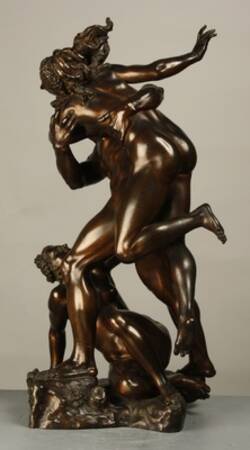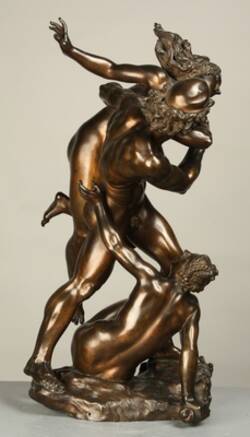Paris awarded the prize in the beauty contest of the Olympic goddesses to Aphrodite, who had promised him the beautiful Helen in return. However, she was married to Menelaus and her abduction triggered the Trojan War. The group represents a refined further development of Giambologna's "Rape of the Sabine", whose composition here has been heightened into the baroque theatrical. Gianfrancesco was the nephew of Antonio Susini, Giambologna's most important assistant.
Further Media






When Paris abducted Helen, he could not have foreseen the dramatic consequences of his actions. He believed he had been promised Helen as his wife by no lesser figure than Aphrodite, the goddess of love.
So what went wrong? To find out, we need to turn back a few pages in this famous story from Greek mythology. To celebrate a marriage, Zeus, king of the gods, invites all the deities – except one, Eris, the goddess of discord and strife. Eris is furious and when the guests gather she throws a golden apple into their midst. The apple is inscribed, ‘For the most beautiful’. Eris’s plan for revenge works only too well. The three goddesses Hera, Athena and Aphrodite each claim the apple. They call on Zeus to adjudicate, but he passes this tricky decision over to a mortal – Paris.
Each of the three goddesses then tries to bribe Paris to choose her. Athena holds out the gift of wisdom, Hera offers to make him the ruler over the world, and Aphrodite promises him the love of the world’s most beautiful woman. In this ‘Judgement of Paris’, as it became known, Paris chooses love – and so Aphrodite won the golden apple. Unfortunately, though, she had failed to mention that Helen was already married. And so Paris set off to claim her – and fate took its course.
The technique of bronze casting is over 2000 years old. The process, which is quite complex, begins with the artist modelling a figure from wax. The wax figure is then coated with clay and allowed to dry. When the mould is heated, the outer layers of clay are baked and the soft wax inside melts leaving the mould to cast the bronze.
However, given the risk of damage when removing an entire mould, a figure is often not cast as one unit, but in individual pieces. In the next stage, enough molten wax is poured into the moulds to form an even wax layer inside. This needs to be as smooth as possible since it later corresponds exactly to the figure’s ‘bronze skin’. The rest of the hollow mould is then filled with a mix of wet clay and sand. When this core has hardened, the individual pieces covered in wax can be removed from their moulds and joined together to form the entire figure. The pieces are joined with core pins and the wax edges smoothed and joined with a hot knife. At this point, the wax intermodel, as it is called, is fully assembled. In the next stage, wax rods are added to the intermodel to provide channels for the bronze during the casting process.
Then the outer mould is built up. To ensure every detail is reproduced, the clay coating over the figure is added layer for layer. After it has been fired, the massive form is inverted so the melted wax can flow out. As the wax rods, known as sprues, melt and form hollow channels, they provide the route to pour in the hot molten bronze into the mould, and at the same time let the air escape. After the metal cools, the sprues are sawn or chiselled off, the holes filled and, in the last step, the surface cleaned, smoothed and polished.
- Location & Dating
- 1626
- Material & Technique
- Bronze
- Dimenions
- H: 52,1 cm, B: 27,7 cm, T: 25,6 cm
- Museum
- Skulpturensammlung
- Inventory number
- ZV 3609